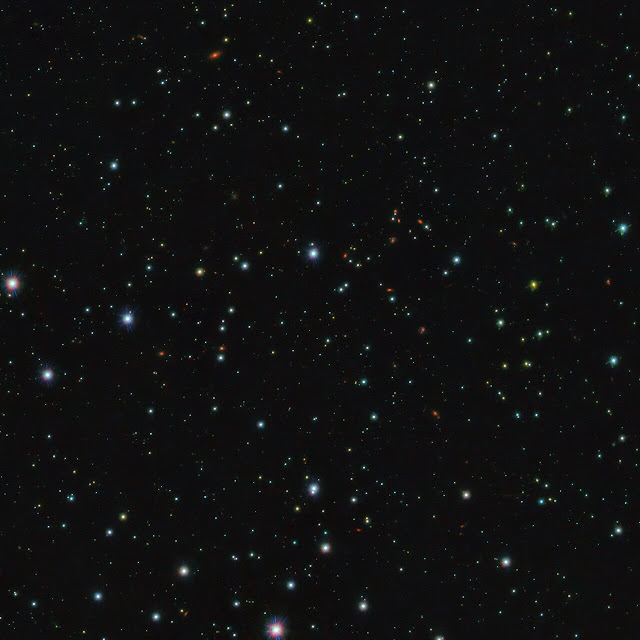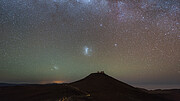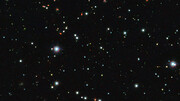Videos
“We did not know how many to expect and are excited to have found so many,” says Núria Miret-Roig, an astronomer at the Laboratoire d’Astrophysique de Bordeaux, France and the University of Vienna, Austria, and the first author of the new study published today in Nature Astronomy.
Rogue planets, lurking far away from any star illuminating them, would normally be impossible to image. However, Miret-Roig and her team took advantage of the fact that, in the few million years after their formation, these planets are still hot enough to glow, making them directly detectable by sensitive cameras on large telescopes. They found at least 70 new rogue planets with masses comparable to Jupiter’s in a star-forming region close to our Sun, located within the Scorpius and Ophiuchus constellations [1].
To spot so many rogue planets, the team used data spanning about 20 years from a number of telescopes on the ground and in space. “We measured the tiny motions, the colours and luminosities of tens of millions of sources in a large area of the sky,” explains Miret-Roig. “These measurements allowed us to securely identify the faintest objects in this region, the rogue planets.”
The team used observations from ESO’s Very Large Telescope (VLT), the Visible and Infrared Survey Telescope for Astronomy (VISTA), the VLT Survey Telescope (VST) and the MPG/ESO 2.2-metre telescope located in Chile, along with other facilities. “The vast majority of our data come from ESO observatories, which were absolutely critical for this study. Their wide field of view and unique sensitivity were keys to our success,” explains Hervé Bouy, an astronomer at the Laboratoire d’Astrophysique de Bordeaux, France, and project leader of the new research. “We used tens of thousands of wide-field images from ESO facilities, corresponding to hundreds of hours of observations, and literally tens of terabytes of data.”
The team also used data from the European Space Agency’s Gaia satellite, marking a huge success for the collaboration of ground- and space-based telescopes in the exploration and understanding of our Universe.
The study suggests there could be many more of these elusive, starless planets that we have yet to discover. “There could be several billions of these free-floating giant planets roaming freely in the Milky Way without a host star,” Bouy explains.
By studying the newly found rogue planets, astronomers may find clues to how these mysterious objects form. Some scientists believe rogue planets can form from the collapse of a gas cloud that is too small to lead to the formation of a star, or that they could have been kicked out from their parent system. But which mechanism is more likely remains unknown.
Further advances in technology will be key to unlocking the
mystery of these nomadic planets. The team hopes to continue to study
them in greater detail with ESO’s forthcoming Extremely Large Telescope (ELT), currently under construction in the Chilean Atacama Desert and due to start observations later this decade. “These objects are extremely faint and little can be done to study them with current facilities,” says Bouy. “The ELT will be absolutely crucial to gathering more information about most of the rogue planets we have found.”
Notes
[1] The exact number of rogue planets found by the team is hard to pin down because the observations don’t allow the researchers to measure the masses of the probed objects. Objects with masses higher than about 13 times the mass of Jupiter are most likely not planets, so they cannot be included in the count. However, since the team didn’t have values for the mass, they had to rely on studying the planets’ brightness to provide an upper limit to the number of rogue planets observed. The brightness is, in turn, related to the age of the planets themselves, as the older the planet, the longer it has been cooling down and reducing in brightness. If the studied region is old, then the brightest objects in the sample are likely above 13 Jupiter masses, and below if the region is on the younger side. Given the uncertainty in the age of the study region, this method gives a rogue planet count of between 70 and 170.
More Information
This research was presented in the paper “A rich population of free-floating planets in the Upper Scorpius young stellar association” to appear in Nature Astronomy (DOI: 10.1038/s41550-021-01513-x). It has received funding from the European Research Council (ERC) under the European Union’s Horizon 2020 research and innovation programme (grant agreement No 682903, P.I. H. Bouy), and from the French State in the framework of the ”Investments for the Future” Program, IdEx Bordeaux, reference ANR-10-IDEX-03-02.
The team is composed of Núria Miret-Roig (Laboratoire d’Astrophysique de Bordeaux, Univ. Bordeaux, CNRS, France [LAB]; University of Vienna, Department of Astrophysics, Austria), Hervé Bouy (LAB), Sean N. Raymond (LAB), Motohide Tamura (Department of Astronomy, Graduate School of Science, The University of Tokyo, Japan; Astrobiology Center, National Institutes of Natural Sciences, Tokyo, Japan [ABC-NINS]), Emmanuel Bertin (CNRS, UMR 7095, Institut d’Astrophysique de Paris,France [IAP]; Sorbonne Université, IAP, France) David Barrado (Centro de Astrobiología [CSIC-INTA], Depto. de Astrofísica, ESAC Campus, Spain), Javier Olivares (LAB), Phillip Galli (LAB), Jean-Charles Cuillandre (AIM, CEA, CNRS, Université Paris-Saclay, Université de Paris, France), Luis Manuel Sarro (Depto. de Inteligencia Artificial, UNED, Spain) Angel Berihuete (Depto. Estadística e Investigación Operativa, Universidad de Cádiz, Spain) & Nuria Huélamo (CSIC-INTA).
The European Southern
Observatory (ESO) enables scientists worldwide to discover the secrets
of the Universe for the benefit of all. We design, build and operate
world-class observatories on the ground — which astronomers use to
tackle exciting questions and spread the fascination of astronomy — and
promote international collaboration in astronomy. Established as an
intergovernmental organisation in 1962, today ESO is supported by 16
Member States (Austria, Belgium, the Czech Republic, Denmark, France,
Finland, Germany, Ireland, Italy, the Netherlands, Poland, Portugal,
Spain, Sweden, Switzerland and the United Kingdom), along with the host
state of Chile and with Australia as a Strategic Partner. ESO’s
headquarters and its visitor centre and planetarium, the ESO Supernova,
are located close to Munich in Germany, while the Chilean Atacama
Desert, a marvellous place with unique conditions to observe the sky,
hosts our telescopes. ESO operates three observing sites: La Silla,
Paranal and Chajnantor. At Paranal, ESO operates the Very Large
Telescope and its Very Large Telescope Interferometer, as well as two
survey telescopes, VISTA working in the infrared and the visible-light
VLT Survey Telescope. Also at Paranal ESO will host and operate the
Cherenkov Telescope Array South, the world’s largest and most sensitive
gamma-ray observatory. Together with international partners, ESO
operates APEX and ALMA on Chajnantor, two facilities that observe the
skies in the millimetre and submillimetre range. At Cerro Armazones,
near Paranal, we are building “the world’s biggest eye on the sky” —
ESO’s Extremely Large Telescope. From our offices in Santiago, Chile we
support our operations in the country and engage with Chilean partners
and society.
- Research paper
- Video and poem about the discovery (available after embargo lifts)
- Photos of the VLT
- Photos of VISTA and the VST
- Find out more about ESO's Extremely Large Telescope
- For journalists: subscribe to receive our releases under embargo in your language
- For scientists: got a story? Pitch your research
Núria Miret-Roig
Department of Astrophysics, University of Vienna
Vienna, Austria
Tel: +43 1427753845
Email: nuria.miret.roig@univie.ac.at
Hervé Bouy
Laboratoire d'Astrophysique de Bordeaux, Université de Bordeaux
Pessac, France
Tel: +33 5 40 00 32 94
Email: herve.bouy@u-bordeaux.fr
Bárbara Ferreira
ESO Media Manager
Garching bei München, Germany
Tel: +49 89 3200 6670
Cell: +49 151 241 664 00
Email: press@eso.org
Source: ESO/News




























